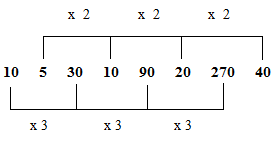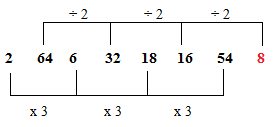TYPES OF NUMBER SERIES
Number Series is one of the important topics in all competitive examinations (UPSC, SSC, IBPS PO/Clerk, SBI, RRB..etc). This is also one of the easy scoring topics. In exams, we can expect two kinds of questions from this topic. One is related to finding a missed number in the series. Other is finding a wrong number in the series.
A number series can be formed with ‘n’ number of types. There are some common types in Number Series. Number Series is all about “Finding the Correct Pattern“. Sometimes we can find it in few seconds. Some problems may take more time. The major types of Number Series are explained below. Make a note of it.
1. Prime Number Series
The Number which is divisible by 1 and itself is called Prime Number. The series formed by using Prime Numbers is called Prime Number Series.
Examples
a) 3, 5, 7, 11,13, 17, _____ , 23 (Find the Missing Number)
Answer is 19.
b) 17, 19, 23, 27, 31, 37, 41. (Find the Wrong Number)
Answer is 27. Except 27 every number is Prime. It should be 29 in the place of 27.
c) 3, 7, 17, 31, _____. (Find the Next Number)
This Problem is little tricky. When we see the number we can easily find that all the numbers are Prime.
Prime Number – 3, 5, 7, 11, 13, 17, 19, 23, 29, 31, 37, 41, 43, 47, 53
In the given series, the numbers are skipped. First One Number is skipped. ie 5. Then Two numbers are skipped. ie 11 and 13. Then Three Numbers are skipped. ie 19, 23, and 29.
The Answer is 53.
2. Addition Series
The series in which the next term is obtained by adding a specific number to the previous term is called Addition Series.
Examples
a) 3, 9, 12, ____, 18, 21, 24.
Answer is 15. Required Term = 12 + 3 = 15.
3. Subtraction Series
The series in which the next term is obtained by Subtracting a specific number to the previous term is called Subtraction Series.
Examples
a) 104, 100, 96, ____, 88, 84.
Answer is 92. Required Term = 96 – 4 = 92.
b) 100, 97, 92, 85, 74, ____.
If you see the difference between the numbers it follows Prime Number Series.
ie 100 – 97 = 3;
97 – 92 = 5
92 – 85 = 7
85 – 74 = 11
The Next Number should be 74 – 13 = 61
Answer is 61.
4. Multiplication Series
The series in which the next term is obtained by multiplying a specific number to the previous term is called Multiplication Series.
Examples
a) 3, 9, 27, 81, 243, _____.
Answer – 729. Each number ger multiplied by ‘3’ here. Required Number = 243 x 3 = 729.
b) 5, 10, 30, 120, ____.
Series Pattern
5 x 2 = 10
10 x 3 = 30
30 x 4 = 120
120 x 5 = ?
Answer is 600.
5. Division Series
The series in which the next term is obtained by dividing a specific number to the previous term is called Division Series. Number which divides the consecutive terms can be fixed or variable.
Examples
a) 10080, 1440, 240 _____, 12, 4.
Series Pattern
10080 ÷ 7 = 1440
1440 ÷ 6 = 240
240 ÷ 5 = 48
48 ÷ 4 = 12
12 ÷ 3 = 4
Answer is 48.
b) 900, 450, 150, 75, ____.
Series Pattern
900 ÷ 2 = 450
450 ÷ 3 = 150
150 ÷ 2 = 75
75 ÷ 3 = 25
Answer is 25.
6. n² Series
When a number is multiplied with itself, then it is called square of a number. A series formed by square of numbers is called n² Series.
Examples
a) 9, 25, 49, 121, _____
Answer is 169.
Hint – The Pattern is Square of Prime Numbers.
b) 1, 9, 25, 49, 81, _____, 169, 225
Answer is 121.
Hint – The Patter is Square of Odd Numbers
7. n² ± 1 Series
If in a series each term is a sum or difference of square term and 1, then it is n² ± 1 Series.
Examples
a) 5, 10, 17, ____, 37, 50, 65
Series Pattern
2² + 1 = 5
3² + 1 = 10
4² + 1 = 17
5² + 1 = 26
Answer is 26.
b) 120, 143, 168, 195, _____ , 255
Series Pattern
11² – 1 = 120
12 ² – 1 = 143
13² – 1 = 168
14² – 1 = 195
15² – 1 = 224
16² – 1 = 255
Answer is 224.
c) 120, 99, 80, 63, ____, 35, 24.
Series Pattern
11² – 1 = 120
10² – 1 = 99
9² – 1 = 80
8² – 1 = 63
7² – 1 = 48
6² – 1 = 35
5² – 1 = 24
Answer is 48.
8. n² ± n Series
The series in which each term is a sum or difference of a specific number with square of that number is called n² ± n Series.
Examples
a) 110, 133, 156, 182, 210, _____.
Series Pattern
10² + 10 = 100 + 10 = 110
11² + 11 = 121 + 11 = 133
12² + 12 = 144 + 12 = 156
13² + 13 = 169 + 13 = 182
14² + 14 = 196 + 14 = 210
15² + 15 = 225 + 15 = 240
Answer is 240.
b) 650, 756, 870, _____, 1122
Series Pattern
25² + 25 = 625 + 25 = 650
27² + 27 = 729 + 27 = 756
29² + 29 = 841 + 29 = 870
31² + 31 = 961 + 31 = 992
33² + 33 = 1089 + 33 = 1122
Answer is 992
c) 380, 342, 306, 272, _____, 210
Series Pattern
20² – 20 = 400 – 20 = 380
19² – 19 = 361 – 19 = 342
18² – 18 = 324 – 18 = 306
17² – 17 = 289 – 17 = 272
16² – 16 = 256 – 16 = 240
15² – 15 = 225 – 15 = 210
Answer is 240.
Similarly Problems related to n³, n³ ± 1, and n³ ± n may come in exams.
9. Alternating Series
- It is a combination of Two Series.
- Two Different Operations may be performed on successive terms alternately.
Examples
a) 10, 5, 30, 10, 90, 20, 270, 40, _____.
Series Pattern

The Next Number is 270 x 3 = 810.
b) 2, 64, 6, 32, 18, 16, 54, _____.
Answer is 8.
10. Arithmetic Progression
The AP Series follows a certain pattern.
The Pattern is a, a + d, a + 2d, a + 3d, …..
In the Pattern ‘a’ is the first term. Common Difference is ‘d’.
Formula is The nth Term, Tn = a + (n – 1)d
Example
a) 678, 683, 688, 693…. What will be the 31st term?
a = 678. d = 5.
T31 = 678 + (31 – 1)*5 = 678 + 150 = 828.
11. Geometric Progression
The GP Series follows a certain pattern.
The Pattern is a, ar, ar², ar³ …..
First Term = a; Common Ration = r.
Formula is the nth Term Tn = arn – 1
Example
a) 8, 16, 32, 64, 128…… What is the 13th Term?
The Pattern is
8 8 x 2 8 x 2² 8 x 2³ and so on…
a = 8. r = 2. n = 13.
T13 = 8 x 2 (13 – 1) = 8 x 2 (12) = 8 x 4096 = 32768
These are some major types of Number Series. We can’t say questions will come from these pattern alone. Well no one can. In Alternating Series lots of combinations can be formed. The key is to practice and get familiar with all patterns. You frame your own questions in Number Series and practice that.
TIP : In Exam If it takes more than 15 seconds to find a pattern, just skip it. Go to next question.











